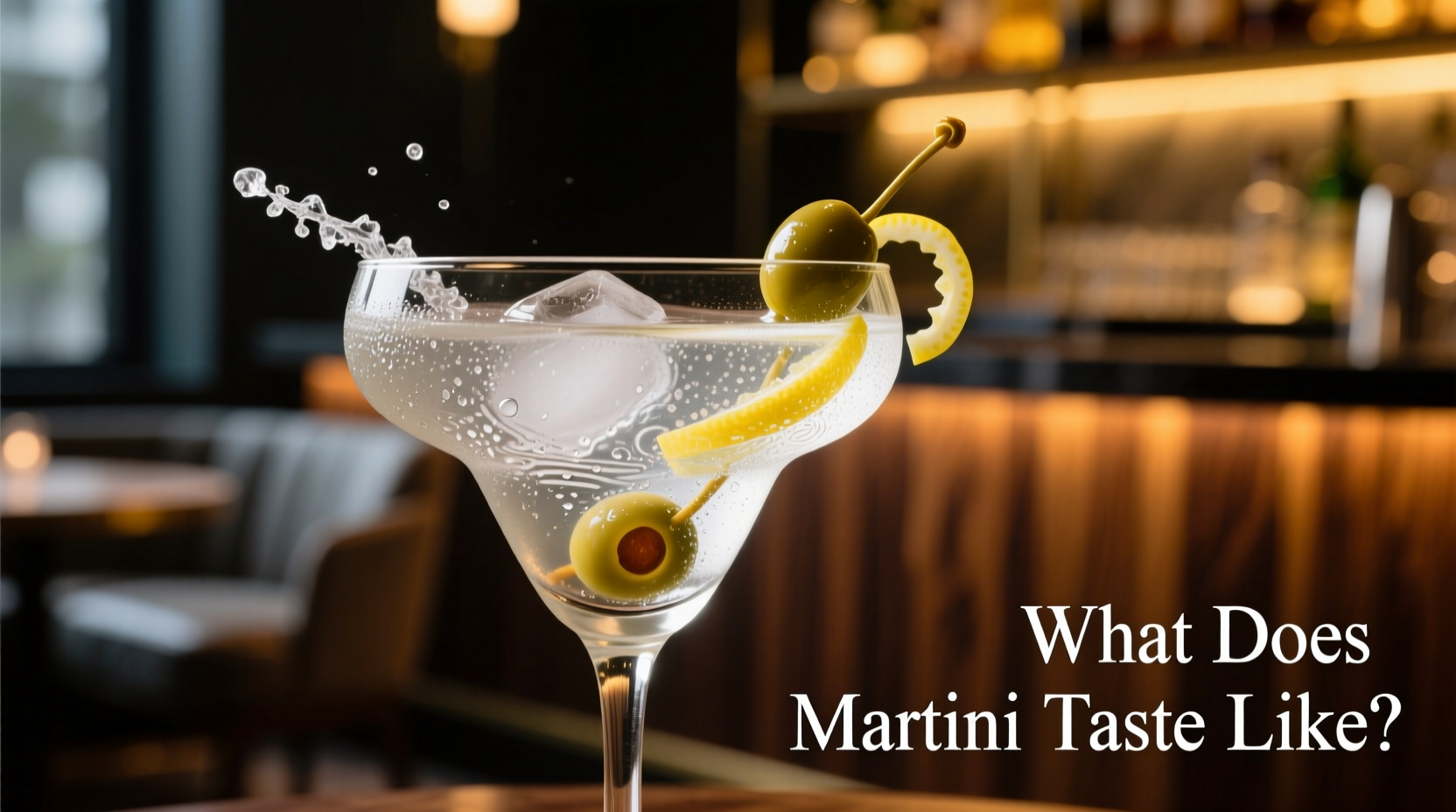Ever wonder what gives a martini its distinctive character? Whether you're ordering one at a sophisticated bar or crafting it at home, understanding the precise flavor profile transforms your experience. This guide breaks down exactly what to expect from each sip, how variations affect taste, and why certain preparation methods make all the difference.
The Essential Flavor Components of a Martini
At its core, a martini's taste derives from three critical elements: the base spirit, vermouth, and garnish. The magic happens in their precise ratio and preparation. Traditional martinis use a 5:1 to 15:1 spirit-to-vermouth ratio, creating that signature dry profile cocktail enthusiasts love.
Gin-based martinis showcase juniper as the dominant note, supported by coriander, citrus peel, and other botanicals depending on the brand. Premium gins like Tanqueray or Beefeater deliver more pronounced herbal complexity. Vodka martinis, meanwhile, emphasize the spirit's clean neutrality, allowing subtle grain or potato characteristics to shine through without botanical interference.
| Martini Variation | Primary Flavor Characteristics | Dryness Level | Alcohol Perception |
|---|---|---|---|
| Classic Gin Martini (6:1) | Juniper-forward with citrus and floral notes | Dry | Present but integrated |
| Vodka Martini (8:1) | Clean, neutral with subtle grain character | Extra Dry | Smoother, less pronounced |
| Wet Martini (2:1) | Herbal, floral vermouth notes dominate | Medium | Less noticeable |
| Dirty Martini | Savory, briny olive juice notes | Semi-dry | Masked by saltiness |
How a Martini Tastes From First Sip to Finish
Your sensory experience evolves dramatically as you taste a properly made martini. Understanding this timeline helps you appreciate its complexity:
- Aroma (0-5 seconds): The initial scent reveals the spirit's character—gin offers piney juniper and citrus, while vodka presents clean alcohol notes. A lemon twist garnish adds bright citrus oils, while olives contribute briny, savory aromas.
- Initial Taste (5-15 seconds): The first sip delivers crisp coldness followed by the spirit's primary flavor. Gin hits with juniper and spice, vodka with smooth neutrality. High-quality vermouth adds subtle herbal complexity rather than sweetness.
- Mid-Palate (15-30 seconds): Temperature warming in your mouth releases secondary botanicals. The alcohol warmth becomes noticeable but shouldn't burn—proper dilution from stirring or shaking is crucial here.
- Finish (30+ seconds): A well-made martini leaves a clean, dry finish with lingering botanical notes (gin) or smooth neutrality (vodka). Poorly made versions leave harsh alcohol heat or medicinal aftertastes.
Factors That Transform Martini Flavor
Several variables dramatically impact how a martini tastes, making it one of the most customizable classic cocktails:
Temperature Matters More Than You Think
Serving temperature directly affects flavor perception. Martinis should be served between 18-22°F (-8 to -6°C). At this temperature:
- Coldness numbs alcohol perception, preventing harshness
- Flavor compounds release gradually as the drink warms
- Over-chilled martinis (below 15°F) mute subtle flavors
According to the International Bartenders Association, proper chilling is essential for balanced flavor release in spirit-forward cocktails like the martini.
Stirred vs Shaken: The Flavor Difference
The age-old debate impacts more than texture:
- Stirred: Preserves clarity and spirit integrity, resulting in cleaner botanical expression (ideal for gin martinis)
- Shaken: Introduces tiny air bubbles that slightly aerate the drink, softening alcohol perception (better for vodka martinis)
Cocktail historian David Wondrich notes in Imbibe! that James Bond's "shaken, not stirred" preference actually creates a subtly different flavor profile with slightly diluted, rounded characteristics compared to the traditional stirred preparation.
How to Properly Taste a Martini Like a Professional
Maximize your martini experience with this professional tasting technique:
- Examine the temperature: Run your finger down the outside of the glass—it should frost immediately
- Assess the aroma: Tilt the glass slightly and inhale gently before sipping
- First sip technique: Take a small sip, letting it coat your entire palate before swallowing
- Evaluate balance: Notice how alcohol warmth integrates with botanical flavors
- Track the finish: Pay attention to how long flavors linger and what remains
This method helps you detect subtle variations between martinis that might otherwise taste "just strong" to an untrained palate.
Common Martini Variations and Their Distinct Flavors
Understanding these popular variations helps you select or request exactly what suits your taste preferences:
Gin Martini vs Vodka Martini: The Fundamental Choice
Gin martinis showcase the spirit's botanical complexity. London Dry gins like Beefeater deliver pronounced juniper with citrus and spice notes, while contemporary gins might emphasize floral or earthy elements. Vodka martinis provide a cleaner canvas where subtle grain or potato characteristics shine through without botanical competition.
As cocktail authority Gary Regan explains in The Joy of Mixology, "The gin martini is a conversation between botanicals, while the vodka martini is a meditation on purity."
Dry vs Wet: The Vermouth Spectrum
The vermouth ratio dramatically shifts the flavor profile:
- Dry (6:1 to 8:1): Vermouth provides subtle background notes without sweetness
- Extra Dry (12:1 to 15:1): Nearly imperceptible vermouth influence, spirit-forward
- Wet (2:1 to 3:1): Pronounced herbal, floral vermouth characteristics
High-quality dry vermouth like Dolin or Noilly Prat adds complexity without sweetness when properly stored and used in appropriate proportions.
When Martinis Taste 'Off': Common Flavor Problems
Several issues can compromise a martini's taste profile:
- Harsh alcohol burn: Indicates improper dilution or low-quality spirits
- Medicinal taste: Often from oxidized vermouth or inappropriate gin selection
- Excessive bitterness: Usually from overuse of orange bitters or poor vermouth quality
- Flat, one-dimensional flavor: Results from using cheap, neutral vodka without character
According to Difford's Guide, vermouth should be refrigerated after opening and used within 4-6 weeks to maintain optimal flavor—stale vermouth ruins even perfectly prepared martinis.

Perfect Pairings: Foods That Complement Martini Flavors
Certain foods enhance rather than compete with a martini's delicate profile:
- Gin martini: Salted almonds, prosciutto-wrapped melon, or oysters
- Vodka martini: Caviar, smoked salmon, or simple salted crackers
- Avoid: Strongly flavored foods that overwhelm the cocktail's subtlety
The key is selecting accompaniments that either contrast or complement the martini's dry, clean profile without dominating your palate.
Developing Your Martini Palate: Practical Tips
Refine your appreciation for martini flavors with these actionable steps:
- Try the same recipe with different base spirits to isolate flavor variables
- Experiment with vermouth ratios using a eyedropper for precision
- Compare stirred versus shaken preparations side-by-side
- Let the martini warm slightly in the glass to experience flavor evolution
- Take notes on your preferences for future reference
Professional mixologists recommend starting with a classic 6:1 gin martini using London Dry gin to establish a baseline before exploring variations.











 浙公网安备
33010002000092号
浙公网安备
33010002000092号 浙B2-20120091-4
浙B2-20120091-4